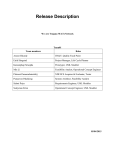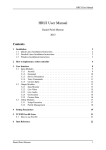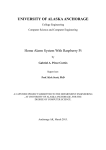Download USER MANUAL-SOCIALTRENDS Step 1 : Setting up Nodejs Note
Transcript
USER MANUAL-SOCIALTRENDS Step 1 : Setting up Nodejs Note: You may skip this step if you already know you have NodeJS installed v0.10.16 Node Version Manager (NVM) is a tool to help install various versions of NodeJS on your linux machine. In order to use NVM ensure you have git and curl installed. Connect to your VPS (droplet) using SSH. If you do not have these installed, use your system's package manager to install them. For example, on an Ubuntu or Debian install you would run: ``` sudo apt-get install curl git ``` Test to make sure the nvm command works by typing nvm at the terminal. If you do not get a command not found error, then you have correctly setup NVM. To install the latest version of Node (which is 0.10.16 at the time of this article), simply type: nvm install 0.10.16 Then wait for the installation to complete. If the install was successful, you should get an output reading: Now using node v0.10.16. Type node -v at the terminal to ensure you are using the specified version. You should get the output: v0.10.16 Step 2: Setting Up Express Express is a web application framework for Node. It is minimal and flexible. In order to start using Express, you need to use NPM to install the module. Simple type: npm install -g express This will install the Express command line tool, which will aid in creating a basic web application. Once you have Express installed, follow these steps to create an empty Express project: mkdir socketio-test cd socketio-test express npm install These commands will create an empty Express project in the directory we just createdsocketio-test. We then run npm install to get all the dependencies that are needed to run the app. MySQL Installation and Configuration Ubuntu / Debian package installation: •apt-get install mysql-client •apt-get install mysql-server mysqladmin -h localhost -u root -ppassword create socialtrends After Nodejs and database configurations run this command: . run.shell And finally, open your localhost port 8001 on your browser.








